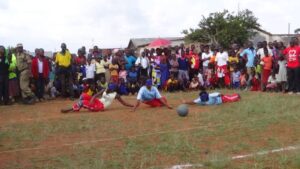By Hiroshi Komatsu

Introduction
The world of sport is not just an arena of competition or a pursuit of fitness; it is, fundamentally, a space for transformation. The UNESCO Charter of 1978 positioned sport as a ‘fundamental right’, anchoring its role in nurturing generations (Howe, 2019). Beyond the physical, sport and physical education have emerged as crucial vehicles to foster societal bonds and carve inclusive communities (Bailey et al., 2009).
Sport as an Inclusive Platform
Inclusive education through sport (IES) promotes inclusivity in sports, fostering growth irrespective of capabilities (European Agency for Special Needs and Inclusive Education, 2015). It emphasises learner participation and minimises educational exclusion. Through communal interactions, prejudices are challenged (World Health Organization and World Bank, 2011), with models like ‘Integrated Sport’ showcasing the benefits (Magnanini et al., 2018). Challenges, remain including gender biases highlighting the need for continuing educator intervention and transformation.
Zimbabwe: The Ground Reality
The United Nations (2022) highlighted that nearly a third of persons with disabilities (PwDs) face discrimination worldwide. In Zimbabwe, where roughly 7% of the populace (over 900,000 individuals) live with a disability (UNICEF, 2013), the gap between legal provisions and the actual experiences of PwDs is starkly evident (Dziva and du Plessis, 2022).
Danhiko: A Symbol of Hope
Amidst this backdrop, Danhiko Secondary School emerges as a beacon, a story of resilience and innovation. It is more than an educational institution; it is a testament to how sport can be used as a bridge to narrow societal divides (Chataika and Hlatywayo, 2022).
Methodological Lens
To understand the transformative canvas of Danhiko, this study, from which the evidence for this blog draws from, embarked upon a qualitative journey, adopting an interpretivist approach.
Voices from Danhiko:
1. Perception of PwDs: Sport is not just about medals and accolades; it is a realm of self-discovery. As Participant 3 revealed, ‘Yes, I am disabled, but I can also help another person’. This encapsulates the shift from viewing disability as a limitation to recognising inherent capabilities. Participant 1’s statement, ‘It changed my physical ability … It’s also built self-confidence’, highlights the profound self-transformative power of sport in their lives.
2. Non-Disabled Participants’ Views: The power of perspective was evident when Participant 8 remarked, ‘I was able to understand that nothing is impossible’. Such revelations challenge existing beliefs and foster inclusivity. The narrative of a disabled teacher participating in a race, as recounted by Participant 11, sends a powerful message: disability is not incapability.
3. Shifting Attitudes: Beyond perceptions, sport influences attitudes. For PwDs, the engagement extended beyond the sport itself. Participant 3 highlighted, ‘We managed to build friendship and just playing together’, underscoring sport’s communal essence. Conversely, for the non-disabled, sport became an eye-opener. Participant 10’s words, ‘It’s not about the physical ability… but it’s a person who [has] thoughts, views, opinions like a normal person’, capture this sentiment.
4. Challenges and Resilience: While the transformative potential was evident, the journey wasn’t without hurdles. Participant 1 highlighted physical barriers, and societal biases remained prevalent, echoed in statements like ‘They always look down upon us”. Yet, the narrative was not one of despair. Strategies like adaptation in sports rules, as shared by Participant 6, showed resilience and innovation in overcoming these challenges.
5. Past Meets Present: The ripple effects of IES extended beyond the playground. Participant 2, with renewed confidence from IES, reported improved social interactions, while Participant 9 credited her enhanced communication skills to her experiences.
6. Environment’s Role: The nurturing environment of institutions like Danhiko can play a monumental role. Participant 1’s experience in a ‘no limitation’ setting and Participant 10’s positive narratives underscore the necessity of supportive ecosystems.
Reflections
Within the narrative on Zimbabwe’s IIES, sport is spotlighted as a crucial mechanism for championing social inclusion, particularly for PwDs (Chataika and Hlatywayo (2022). By weaving sport into the educational fabric, perceptions evolve, recognising the expansive potential of PwDs and diminishing potential biases.
The transformative power of sport enables inclusivity, elevates self-worth, and nurtures substantial relationships (Seymour, Reid, and Bloom, 2022). Obstacles, such as limited resources, remain, yet the potency of sport in contesting stereotypes and advocating inclusivity has yet to be maximized.
The research highlights the imperative of strategic partnerships and societal backing to harness IES’s quintessential potential in recalibrating perceptions and amplifying inclusivity. Political will coupled with public engagement and support can make a difference.
Sport, as showcased by Danhiko Secondary School, is more than a game – it is a movement towards inclusivity. This Zimbabwean narrative, rooted in experiences and voices, supports sport’s transformative potential in not just shaping bodies, but minds and societies.
The lesson from Danhiko is not just at a local tale – it is a potential global lesson in resilience, inclusivity, and the transformative power of sport.
Recommendations
Inclusive education through sport within education can reshape societal perceptions. The following recommendations emerged:
Deepen Cultural Understanding: Delve into the cultural influences on IES acceptance and devise strategies to counteract negative perceptions of disability.
Inclusive Sports and Infrastructure: Policy decisions should accentuate inclusive sports for PwDs and channel investment into accessible sports facilities. International collaboration should be fostered to pool resources.
Training and Awareness: Give priority to continual training for educators in disability awareness and adaptive teaching methods. Furthermore, heighten public awareness regarding the wider societal repercussions of IES.
Align with Global Goals: Ascertain that IES initiatives are in harmony with the Sustainable Development Goals, underscoring inclusivity, peacebuilding, and employment avenues for PwDs.
Expand Research Scope: Broaden the research parameters to encapsulate a more varied participant base and settings, acknowledging diverse disability categories and geographical nuances.
Refine and Develop Co-Production and Inclusive Methodologies: Augment research techniques to be comprehensive for all disability types, ensuring a more holistic understanding.



